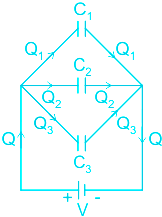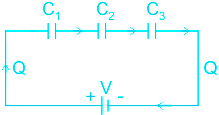Solutions
Concept:
According to charge conservation, the capacitor with minimum charge(Q) will reach it’s saturation first and will breakdown first.
Charge (Q )of capacitor for given capacitance (C) & Voltage(V) is given by
Q = CV,
Combination of capacitors:
Parallel combination:

When two or more capacitors are connected in such a way that their ends are connected at the same two points and have an equal potential difference for all capacitor is called a parallel combination of the capacitor.
Equivalent capacitance (Ceq) for parallel combination:
Ceq = C1 + C2 + C3
Where
C1 is the capacitance of the first capacitor,
C2 is the capacitance of the second capacitor
C3 is the capacitance of the third capacitor
Series combination:

When two or more capacitors are connected end to end and have the same electric charge on each is called the series combination of the capacitor.
Equivalent capacitance (Ceq) in series combination:
Calculation:
Charge on each of the capacitor (Q) = 4500 μC
As all the capacitors are connected in series, the charge in the circuit is 4500 μC
Voltage across the series combination (V) = 135 V
Let the equivalent capacitance of series combination is Ceq
Q = Ceq V
4500 = Ceq × 135
Ceq = 33.33 μF



 Get latest Exam Updates
Get latest Exam Updates 





 ×
×






